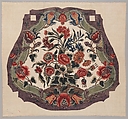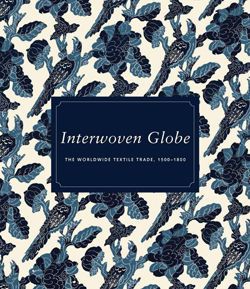Chair seat cover
Indian, possibly western, for the European market
Not on view
While the intended use of some Indian chintzes is difficult to determine, there can be no doubt that this panel was made to cover a European-style chair seat, although it was never used. The design’s overall shape indicates that it was created specifically for an English chair dating between about 1720 and 1740.[1]
In comparison with the number of extant furniture frames from the eighteenth century, relatively few pieces of intact upholstery from that period have survived. We know that contemporary upholstery fabric—whether woven silk or wool, embroidery, or painted and dyed cotton, like the present example—was often ordered before the frame itself, which was then made to accommodate the textile. The fragility of this fine cotton fabric makes this survival all the more remarkable; had it been used, the seat cover would not be in such pristine condition. Parts of two related curtains also exist,[2] and the three pieces were likely from one matching suite of furnishing chintz. This suite was perhaps made specifically for an English East India Company employee, who could have potentially circumvented the official prohibition on Indian cotton imports into Great Britain in force between 1721 and 1774, although none of the extant pieces has a company mark to confirm this attribution.
More naturalistically drawn than in most Indian chintzes, the flowers can readily be identified as varieties common to European gardens of the time—roses, carnations, and hyacinths, among others.[3] The seat cover design can be compared with European embroidered upholstery of the period, particularly English pieces made of wool and silk tent stitch on canvas; some of these embroideries also depict exotic-looking goods along with the flowers, such as a blue-and-white ceramic vase that contains the bouquet on an English chair upholstery dated 1739 (MMA no. 1974.28.204a,b).
The composition of this painted-and-dyed cotton chair seat is, in fact, a domesticated variation of the Tree of Life palampore—with the tree minimized. A room furnished with a suite of this Indian chintz design would have had a look very different from that of a room furnished with grand Tree of Life hangings: the exotic forest has been transformed into a garden of familiar flowers, with borders that contain fantasy flora and leaves similar to those found on other Indian cottons. We have further proof here of the Indian cotton painters’ ability to adapt their considerable talents to specific tastes.
[Melinda Watt, adapted from Interwoven Globe, The Worldwide Textile Trade, 1500-1800/ edited by Amelia Peck; New York: Metropolitan Museum of Art; New Haven: distributed by Yale University Press, 2013]
Footnotes
1. Thank you to Nancy C. Britton, Conservator, Department of Objects Conservation at the Metropolitan Museum, for confirming the date range and for her identification of the shape as intended specifically for an English chair of this period.
2. The two curtains are in the Cooper-Hewitt, National Design Museum, New York (no. 1968-79-2), and the Royal Ontario Museum, Toronto (no. 934.4.25); see Irwin and Brett, Origins of Chintz, pp. 90–91, pl. 58.
3. Ibid., p. 90, catalogue entry for the matching curtain in the Royal Ontario Museum; the curtain also displays variegated tulips, which do not appear on the seat cover.
This image cannot be enlarged, viewed at full screen, or downloaded.



